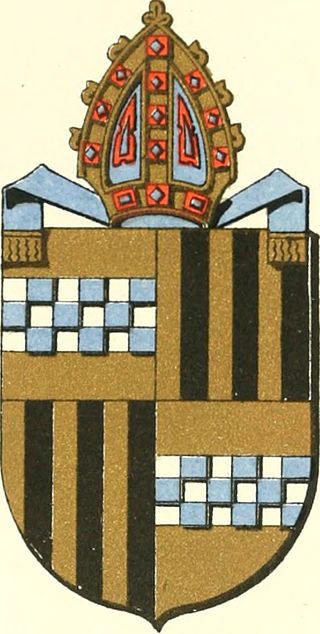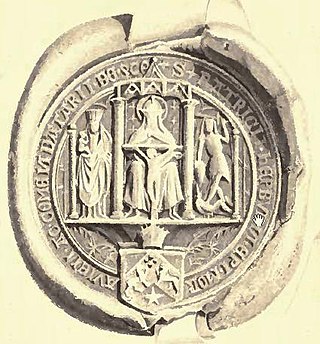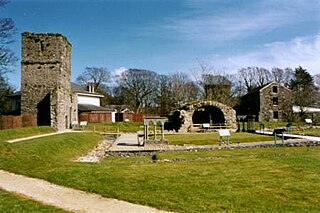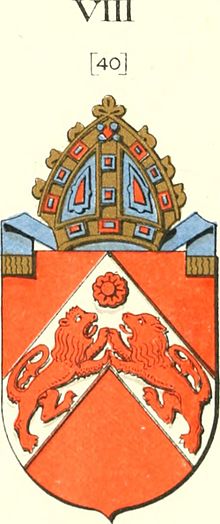John de Ralston was a 15th-century Scottish bishop and administrator. He was regarded as illegitimate, although today his parents are not known. Ralston appears in the records for the first time in 1426, where he is chaplain and secretary to Archibald Douglas, 5th Earl of Douglas. He retained this position on the death of Douglas in 1439. Between 1429 and 1443 he served as the fourth provost of Bothwell Collegiate Church, the home church of the Douglas earls. On 26 November 1445 he became dean of the diocese of Dunkeld.

Andrew Stewart was a 16th-century Scottish noble and cleric. He was a legitimate son of John Stewart, 1st Earl of Atholl and Eleanor Sinclair, daughter of William Sinclair, Earl of Orkney. His paternal grandmother was Joan Beaufort, former queen-consort of Scotland. Andrew chose an ecclesiastical career, held a canonry in Dunkeld Cathedral and was rector of Blair parish church, a church under the control of the earls of Atholl.
Donald Campbell was a 16th-century Scottish noble and churchman. He was the son of Archibald Campbell, 2nd Earl of Argyll and Elizabeth Stewart, daughter of John Stewart, 1st Earl of Lennox. From 1522, he was a student of St Salvator's College, at the University of St Andrews. After graduation, he became a cleric in his home diocese, the diocese of Argyll.
Robert Crichton was a 16th-century Scottish Catholic cleric.

Patrick Hepburn was a 16th-century Scottish prelate. He served as both pre- and post-Reformation Bishop of Moray.
William de Cambuslang was a 14th-century Scottish churchman, presumably coming from a family based at or originating from Cambuslang near Glasgow.
Radulf is an obscure churchman in early 13th-century Scotland, elected as Bishop of Dunblane some time between 1223 and 1225. The first of only two notices of his existence occurs in an Arbroath Abbey deed where he is styled "Radulf elect of Dunblane"; the document can be dated to 1223–1225. On 12 January 1226 Pope Honorius III instructed the Bishop of St Andrews, the Bishop of Moray and the Bishop of Caithness, to enjoin a new election for the bishopric of Dunblane, as "R. elected Bishop of Dunblane" had resigned in the Pope's presence a short time before. There are no clues as to Radulf's career after that. The Cathedral chapter of the diocese elected one Osbert in his place. Cockburn suggested Radulf was probably a Frenchman who had immigrated to Scotland, who got elected Bishop, but decided he would rather stay in Continental Europe after he travelled there for consecration, perhaps being offered a better post there.
William O. Tiron. was a late 13th-century Tironensian abbot and bishop in the Kingdom of Scotland. He appears in the extant sources for the first time on 25 April 1276; he is Abbot of Arbroath. According to the Scotichronicon, the work of the 15th-century historian Walter Bower, William's predecessor Adam de Inverlunan had died in 1275, so William probably became abbot in either that year or in 1276.
Jonathan was a churchman and prelate active in late twelfth- and early thirteenth century Strathearn, in the Kingdom of Scotland. He was the Bishop of Dunblane during the time of Gille Brigte of Strathearn, and it was during Jonathan's episcopate that Gille Brigte founded an Augustinian priory at Inchaffray.
John Herspolz or John Hepburn was Bishop of Dunblane. On the day of the resignation of the bishopric of Dunblane by Robert Lauder at the papal curia – 12 September 1466 – Pope Paul II provided Herspolz/Hepburn as Lauder's successor.
John Spalding was a 15th-century churchman based at Brechin in Angus, Scotland. Spalding became Dean of Brechin in 1456; he was confirmed in this position by the Pope on 5 October 1458.

James Chisholm, Bishop of Dunblane, was the eldest son of Edmund Chisholm, the first Chisholm to own the estate of Cromlix in Dunblane parish, Strathearn, having moved from the Scottish Borders. In his early years as a clergyman, he was a chaplain to King James III of Scotland; the king apparently sent him to Rome for some time.

William Russell was a fourteenth-century Cistercian prelate. He appears to have begun his career as a Cistercian monk at Rushen Abbey on the Isle of Man (Mann), ascending to the rank of abbot there, before being elected Bishop of Mann and the Isles (Sodor). After traveling to Continental Europe for confirmation and consecration, avoiding a trip to the metropolitan in Norway, he returned to the Irish Sea as a legal bishop. A few things are known of his episcopate, particularly his activities in England and a series of provincial statutes apparently promulgated under his leadership.
Thomas de Rossy was a fourteenth-century Scottish prelate. He appears in the historical record for the first time in 1331, when Pope John XXII provided him to succeed Bernard as Bishop of the Isles. At this stage, the papal sources name him as a canon of Dunkeld Cathedral.
Alasdair Caimbeul or Alexander Campbell of Carco was a Scottish noble and prelate. Coming from a branch of Clan Campbell in the allegiance of the Earl of Argyll, his career began in the 1560s still only a minor, serving the Earl of Argyll's interest. He was made Bishop of Brechin, and almost immediately alienated the majority of the bishopric's historical resources into the hands of the earl.
William Meldrum was a prelate in the late 15th- and early 16th-century kingdom of Scotland. He appears to have come from the Meldrum family of Seggie, as suggested by the otters on his arms.

William de Crachin was a prelate active in the Kingdom of Scotland in the 13th century. The earliest known Dean of Brechin Cathedral, his first appearance in a surviving source comes 22 September 1248, from a document of Arbroath Abbey.
Nicholas was a Scottish churchman and prelate active at the end of the 13th century. While holding the office of sub-dean of Brechin Cathedral, he got provided bishop of Brechin by Pope Boniface VIII on 21 January 1297.
George Shoreswood or Schoriswood, was a prelate active in the Kingdom of Scotland during the 15th century. He appears to have been of English-speaking origin, from the family of Bedshiel in Berwickshire.
John de Crannach was a 15th-century Scottish scholar, diplomat and prelate. Originating in the north-east of Lowland Scotland, he probably came from a family associated with the burgh of Aberdeen. Like many of his relatives, he flourished in the 15th-century Scottish church. After just over a decade at the University of Paris, Crannach became a servant of the then Dauphin Charles (VII).





